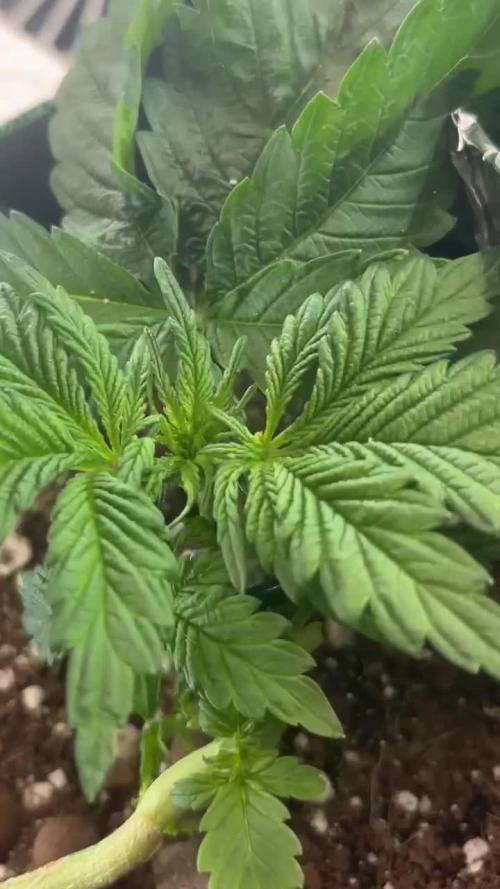The Grow Awards 2026 🏆 



































Likes
Comments
Share


@m99smith
Follow
Week 8 for Mango Merengue, week 7 for Afghan Hash, and week 6 for Sour Diesel.
I'm taking down Pheno #1 of the Mango Merengue today, it was faster to mature then Pheno #2 & #3. Pheno #2 & #3 have around 1-2 weeks left of flower.
Mango Merengue - Small to Medium buds, strong Gassy/Melon smell, and packed with trichomes, average flowering time 8-9 weeks.
Afghan Hash Plant- Medium buds, packed with trichomes, and has a Sweet/Earty smell. Average flowering time 8-9 weeks.
Sour Diesel - Medium to Large buds, also packed with trichomes, really close bud formation, smells Gassy/Sweet. Average flowering time 10 weeks.
Likes
17
Share


@Fishcake
Follow
The girls got the chop last Friday having a bit of bother with humidity at 70% at 23 c but I can get it down to 60% humidity but the temps drop to around 16 c I'm also attempting to reveg the zupreme just incase its nice lol I already have a baklava reveging now will make a diary for those tomorrow
Likes
3
Share


@Nonem420
Follow
Day 70
Sorry, from now on i will update very little, i'm not doing soo much at this point, just keeping feeding. Tomorrow last big defoliation.
Day 72
It's becoming pretty difficult to shoot photos in there.. i barely have space to add water to the buckets ( now 8 liters every day), added net for support and "constriction" of pinus because she's huge and was starting to trow shadow on the fresh pressed runtz.
Likes
7
Share


@darb35
Follow
Week 3 of flowering!
I am planning on moving the girls into a bit bigger tent (70x70x160) so hopefully I have a bit more room to grow tall.
They will probably reach about 60 cm and that is the limit for the current tent.
I hope to get the humidity down to the range of 40%, but this month is very humid in Berlin 😶🌫️
Likes
17
Share


@CanadianFillmore
Follow
Week 6 begins with a 3 liter feeding and removal of a few dead leaves. Buds are developing nicely and frost is present, woo hoo!!
Thanks for stopping by.
Processing
Likes
4
Share


@Green_Thumb
Follow
My oldest girl had her flush this week and its about time for her to finish up. I will continue the journal for my 2nd oldest so stay tuned!
Likes
13
Share


@Chubbs
Follow
420Fastbuds
FBT2311/Week 6
What up growmies. Weekly update on these beautiful ladies. This week we've had some temperature swings and wow did they not like getting down into the high 50's. They both bounced back but won't be letting it get that cold again if I can help. Flower sites are all over with pistols. No signs of any major issues so will keep the same routine. All in all Happy Growing
Likes
41
Share


@Skinnytalls420
Follow
Day 94-23/01/22 still got 4 that are takeing really long time the rest are drying
Likes
3
Share


@ChameleonsCannabis
Follow
I love sativa. This is a great freaking plant. Long skinny buds (a little squeezed by me :) and the smell is incredible (strong put in jar open 5 min later my house smells strong) its sweet from the haze but it's got that gassy fuel smell to it also with a tiny bit of earthy after aroma. It's wonderful smokes great gets me higher than any weed at the stores and I never have coughed from it I don't think it's so smooth. Organically grown buds are fckin smooooothh man I never would have understood until I grew organic! This bud is the tits I'm stoned off a mix of blueberry amnesia haze northern ligbt joint as I write this lmao good harvest
Likes
Comments
Share


@GreeneScene
Follow
Week#7 Day#44 Update: shes looking nice and bushy from the ponytailing. I gave her a half a gallon of water and she drank it right up . I gave it to her day 42 I believe I noticed her leaves droopy. I still have not topped her yet there’s atleast 13 main arms needing to be pinched out currently.
I’m still riding the fence with whether I’ll top dress feed her and keep her in this pot for one more month or will I transplant her up and boost the feed proportionately with the increased pot size .
Week#7 Day#45 update since I can’t seem to stop riding the fence on the methods I want to use to grow this plant I decided I atleast needed to do a heavy defoliation to expose those growth sites to encourage more branching . I could continue with ponytailing & defoliation for a while I just keep kicking the can around on whether topping will make this healthy vigorous growing plant better . It’s already doing everything I could ever want in terms of lateral growth . Could it stand to be a bit more vigorous on the upwards growth ? Sure , however I’ve still got 3 ladies maturing up in this tent that I need to move out so I’m sort of happy shes not requiring a lot of leg room know what I mean ?
I think as the fan leaves grow out I’ll pony tail up each top again .
Week#7 Day#46
No changes
Week#7 Day#47: started pony tailing her tops as the fan leaves get large enough to pin up I’ll cover as many as possible to let those lower growths get growing .
Week#7 Day#48: still pony tailing tops 😁 we’ll make her into a
Week#7 Day#49: those new fan leaves neeed to be pony tailed but are also incredibly yellow . I wanted to try putting the dry amendment at the bottom of my planter but for the sake of time I won’t experiment & have wasted a 2 weeks considering I knew last week she “ should be getting hungry “ & it’ll take 1 week of top watering before these dry amendments are available to the plant so she may stay e looking deficient. I gave her 2 heaping tablespoons & watered her in with 1/2 gallon of ph’d water with (organic)cal mag .
Likes
11
Share


@UrbanBoer
Follow
Can I just say, these plants growth and development have been awesome, in the beginning she just grew horizontally and at a snail rate, but in my absence it’s like she was preventing her growth, and the problem with Monday’s Blue, it’s pot was not filled to the brim with grow medium (alike Unknwon Strain), unlike the other 4 plants so it did not get enough wind and sunlight, but guess what, nature always makes a plan. Look at her now.
Likes
2
Share


@Saintvicious
Follow
Holy Lst. Getting crazy now for just a few weeks from seed. No stopping it now.
Likes
7
Share


@Cannerd
Follow
Week 6 Vegetation - "Sam" rate of growth started to increase near the beginning of the week. With the nodes now stretching, I've started to implement tucking of the larger fan leaves under new and smaller shoots. I find this "new growth priority" method paired with LST really maximizes and speeds up the growth in comparison to an untrained plant. Merely anecdotal though!
You'll notice that in the 3rd shot, the nodes stretched out in about 2 days and just ballooned! now that's what I'm talking about! nearing the middle of the week and the rate of growth is fast enough that I can't remember to take enough pictures between the new nodes. At this point I'm tucking new leaves almost daily, making paths for the light to reach new growth tips.
By the end of the week, I'll need to start tying the nodes to the side before they stretch too far up. If they stretch too far before tying them, they can be a PITA to tie down later with dense foliage and such. Tying them down before they get to this point also keeps the nutrients moving to the "new side-nodes" from these branches. Eventually these will be just as thick as the original main stalk.
UPDATE:
As you can see with the last photos added, the branches are almost even with the original top of the plant that was tied down. I gave them a thorough fertigation the night before, and only slight folding of the leaves so I must have choked the roots a bit, but nothing long term.
Processing
Likes
5
Share


@PETEROG
Follow
Hey guys everything is going great with these ladies all 6 germinated and popped up in 3 days after planting 1 of the six shooters is a lot smaller than its sisters so I've order LEMON PIE from FASTBUDS should be here tomorrow to take its place and I'm going to move the six shooter outside so if you would like to see its journey comment and like bellow ⤵️
The only thing I wish I did differently would of been starting these girls under a cfl or a cheap led to stop stretching but lesson learned if anyone has any question's please comment and thank-you all for your support ✌️
Likes
2
Share


@420DeepGrow
Follow
📆 Semana 7
La Papayton de 42 Fast Buds sigue su evolución espectacular. Los cogollos se vuelven más densos y pesados, cubiertos de una resina brillante que resalta cada detalle. Los tonos grisáceos se mezclan con matices rojizos, creando un contraste único que anuncia la madurez avanzada y un carácter muy definido. Las ramas laterales siguen sosteniendo con fuerza el peso floral, mientras la reducción de hojas permite que cada cogollo luzca en todo su esplendor.
El aroma tropical se intensifica, dulce y afrutado, impregnando el espacio con notas exóticas y envolventes. La formación de tricomas se acelera, presagio de una floración potente y llena de brillo.
🌸 La planta sigue demostrando equilibrio y vigor, acercándose a su punto álgido con una energía contagiosa.
¡Seguimos creciendo fuerte 💪!
Likes
3
Share


@psychonaut420
Follow
The plants structure has become more sturdy and have seen development of more side branches developing I have topped both side branches at the 2nd node as didn’t want to top main bud site and have been doing light defoliation of the bigger fan leaves hoping to see more development as week 4 progresses
Likes
7
Share


@Garythegardener
Follow
Shes growing really well a very sturdy and easy plant to grow.
Everything as should be no deficiencies to talk of.
Lots of tops created by daily lst.
Seeing her hit her growth spurt and also showing us some lovely pistills.
Shes very straight forward to deal with
Likes
12
Share


@Luv2Grow
Follow
Day 71 - Starting week 11 today and starting to see a few orange and brown pistils but still plenty of healthy white ones but trichs are still clear with a few milky in there. All looks good and will be ready for some water tomorrow.
Day 72 - Nothing new, noticing a bit more pistils shriveling up a bit so I’ll probably give her another week or so and then possibly start flushing her. She did get 2 gallons of plain water today.
Day 74 - She’s still chunking up quite a bit and looks like the pistils are finally starting to fade a bit but a ton still nice and healthy. Another day or two and she’ll be ready for some water again.
Day 75 - She’s coming down to the end with just a couple weeks left. She needs some water so gave her 2 gallons today and next watering I’ll start the pre-harvest feeding with just MagiCal and SugarDaddy.
Day 76 - Nothing new today, just a forest of trees getting fat and stinky.
Day 77 - The end of week 11 and still looks like she’s got a good couple weeks left, as of right now. Not gonna give her any nutes and just plain water from here on out.













